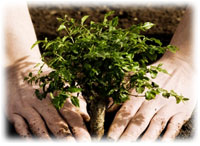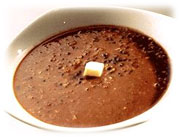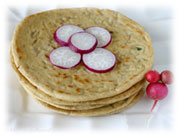 |
|
Sustainable Development in India |
India has adopted a new paradigm of thinking and experience of development post-Stockholm Conference of 1972 called Sustainable Development .Following which, India became a part of 187 countries agreeing on carrying out an important commitment towards Sustainable Development by signing the Rio Declaration during 1992 UN Conference on Environment and Development.

Since then the Concept of sustainable development is adopted such that the country and society can meet the needs of the present without compromising the ability of future generations, to meet their own needs and the level of growth rates is commensurate with social, economic and environment development.
|
Shortcomings in maintaining the Balance for a Sustainable Development |
Population, Literacy rate and Economic Distribution
- India constitutes around 17% of the world's population, but account for about 35% of the poor and 40% of the illiterates in the world.
-
Experiences from the economic reform indicate that while there have been improvements in economic growth, foreign exchange, IT revolution, export growth, inequality in income distribution has been growing simultaneously.
Effects of Climate change on Subsistence and livelihoods
- In India around 700 million people in the rural area are directly dependent on climate-sensitive sectors (agriculture, forests, and fisheries) and natural resources (such as water, biodiversity, mangroves, coastal zones, grasslands) for their subsistence and livelihoods.
- Water, soil, and air, which are the vital environmental sources for maintaining life, have been shrinking alarmingly.
- This will further reduce the adaptive capacity of dry land farmers, forest dwellers, fisher folk and nomadic shepherds, which is already very low.
Impacts of Climate Change and Need of the Increasing Population on the Water Sector
-
Annual per capita availability of renewable freshwater has been decreasing from 5,277 m 3 in 1955 to 1,820 m 3 in 2001.
- The main reasons for the water crisis are increasing demand, zonal disparity in distribution, lack of ethical framework for use, inadequate knowledge and resources, major land-use changes, long-term water level decline, and increase in salinity and pollution.
Depletion of Renewable Resources
-
All the demands of developing and developed nations require the manipulation of natural resources. No economy can survive without coal, petroleum, electricity, wood and steel.
- Fossil fuels, which satiate the hunger for resources in most economically progressing nations, are non-renewable and unsustainable. Already, their production has declined and they are moving towards exhaustion. Although fossil fuels are being generated continuously, we are using them at a rate 100,000 faster than they are renewed. Mother Nature can definitely not enhance her production capacity to meet our ever-increasing need of these elixirs of industrial era.
-
The world is now confronted with the challenge of optimizing the use of the currently available resources in a way to meet the needs of the present generation without compromising on the requirements of the future generation.
|
Inclusive Growth: Need of the Hour |
|
To meet the challenging situation of widening economic and social disparity, inclusive growth is the best tool, but it is a dream without improvement in agricultural growth, employment generation, poverty reduction, involvement of the social sector (health, education, and women empowerment) and conserving our natural resources.
Education and Women Empowerment for a better future
- Literacy and a basic education are essential for enabling the poor to access the benefits offered by development initiatives and market opportunities.
- Education is a potent tool in the emancipation and empowerment of women.
It is indispensable that education enables women not only to gain more knowledge about the world outside of her home but helps her to get status, positive self esteem, and self confidence , necessary courage and inner strength to face challenges in life.
Conserving Water for Future
- Ground water conservation practices like construction of khadin (popular in Maharashtra, Andhra Pradesh, Madhya
 Pradesh, Tamil Nadu, Karnataka, and Gujarat), check dams, farm ponds, recharge shafts, injection wells (in coastal region and to combat problems of heavily pumped out aquifers), and contour trenching, to arrest surface run-off at elevations, and similarly surface water conservation techniques, like construction of ooranies (surface water collection ponds with improved catchments, commonly found in Tamil Nadu), are important measures to tackle problems of water scarcity and the decreasing ground water table. Pradesh, Tamil Nadu, Karnataka, and Gujarat), check dams, farm ponds, recharge shafts, injection wells (in coastal region and to combat problems of heavily pumped out aquifers), and contour trenching, to arrest surface run-off at elevations, and similarly surface water conservation techniques, like construction of ooranies (surface water collection ponds with improved catchments, commonly found in Tamil Nadu), are important measures to tackle problems of water scarcity and the decreasing ground water table.
- Generation of awareness and training among the masses for water conservation via roof top rain water harvesting and threshing floors can also be implemented.
- Involvement of the Gram Panchayat / Village Health and Sanitation Committee for operation, maintenance, and surveillance of water quality, as in the National Rural Drinking Water Quality Monitoring and Surveillance Project, can have a major impact. Other measures like recycling and reuse of water, using water-efficient household equipment such as low volume flushing cisterns, proper metering of water, rational tariff, and the concept of a water-efficient home, would reduce water demand and encourage conservation.
Agricultural Development

-
Integrated development of drought-prone areas can be done by long-term preventive measures like afforestation, pasture development, and livestock management, (by growing better top feed species, which can survive annual droughts and provide rich fodder).
-
Contingency crop planning can be implemented by growing various combinations of crops, fruits, trees, and grasses, to minimize the risk of crop failure and to provide stability to farm income.
- Efficient land management and irrigation technologies like sprinklers and drip systems should be popularized, which aim at maximizing the production per unit of irrigation water.
- The National Rural Employment Guarantee Act (NREGA) is presently one of the most credible programs that deals with chronic poverty and improving sustainable development in rural areas. Under NREGA, up to two-third of the activities are for water conservation (52%) and land development (14%), a step toward sustainable development.
Biofuels: Eco-friendly Option for future
- The future of our planet depends on our use of the available resources. This does not mean that we stall all progress to save the resources for our future generation. It calls for efficient use of non-renewable resources.
- Wastage of such resources must be minimized and alternative sources should be made more feasible for even the common man. By shifting the energy burden from non-renewable to renewable resources, we can stand up to the challenges of the future.
- A lot can be done using Biomass, biofuels, hydroelectric energy, tidal energy, nuclear energy, fusion power, wind power, solar power, and geothermal energy. These are welcome options to ease the burden on our over pressed fossil fuels.
- Hydroelectric energy serves as an alternative way of generating electricity. In this way we can spare some of the coal which would have otherwise been used for this very process.
- Yet another way to produce electricity is through the use of Biomass, which involves using garbage, vegetable matter. On decomposing, garbage releases methane (the root cause of all the stench) which is captured in pipes and can later on be used to produce electricity. Garbage can aptly be called a blessing in disguise!
|
For improving the present ecological conditions, India has taken a number of stringent steps, such as,
- Registration of the largest number of Clean Development Mechanism (CDM) projects (31%) in the world. CDM or carbon credits is a mechanism devised under the Kyoto Protocol to award encashable points to eco-friendly projects, on the basis of carbon emissions they control.
- A Mumbai start-up, Sustainable Technologies and Environmental Projects Ltd (STEPS), has discovered a way to convert plastic, organic, and electronic waste into petroleum without the usual harmful residue. Such plants, which cost US$ 2 - 3 million each, can produce up to 25,000 liters of petroleum a day, at an operating cost of Rs. 12 per liter (excluding cost of raw materials).
India is also trying to replace 10% of its transport fuels with environment friendly biofuels (mixing ethanol, doping diesel, and nonedible oil) in the next 10 years, to cut carbon emissions.
- A new initiative of the US Green Building Council-Leadership in Energy and Environmental Design (USGBC-LEED) - an organization that uses the 69-point criteria to award certificate at the platinum, gold, and other levels to buildings. Today, our country has over 25 million square feet of registered green building expanse, which is all set to touch 100 million square feet by 2010-12. ITC Green Center in Gurgaon, is the world's largest green building, with a space of 170,000 square feet, and the first non-commercial complex in our country to be awarded a platinum rating by USGBC-LEED.
- People participation in the form of Corporate Social Responsibility (CSR), as a means of reducing the social and economic disparity and improving ecological conditions through various activities via the corporate sector like health, education, natural resource management, infrastructure development, community support, non-farm and farm-based livelihood development.
|
We have a path for sustainable development,
but unless all our methods are directed toward it,
we cannot achieve sustainable development. |
| |
Source :
http://sdnp.nic.in/
http://www.desd.org/Esd_india.htm
http://theviewspaper.net/need-of-the-hour-sustainable-development/
http://www.ijcm.org.in/article.asp
http://www.articlesbase.com/education-articles/ |
 |
| |
|
 |
| |
| |
Holi Special Recipe
GUJIA |
| Ingredients: |
| Khoya |
1 kg |
Sugar
|
500 gms |
| Maida |
500 gms |
Almonds, chopped
|
200 gms |
Cooking oil
|
6 tbsp |
Raisins
|
3 tbsp |
Water |
200 ml |
|

Method:
Combine maida with 6 tbsp of oil using your fingers.
Make soft dough and knead it lightly. Add water if needed.
Cover with a wet cloth and leave aside.
In a frying pan, deep-fry the khoya till light brown in color.
Add chopped almonds, sugar and raisins and mix well.
Fry again for few minutes. Allow the mixture to cool.
Prepare a small and thick chapati from the kneaded dough.
Stuff half of the chapati with the khoya mixture.
Fold and draw the edges of chapati inwards to close.
On slow fire, deep-fry the gujia till golden brown.
Take out using a sieve and drain the oil properly.
Store them in an airtight container.
Repeat the procedure with remaining dough.
|
|
| Recipe taken from : http://www.indobase.com/recipes/details/gujia.php |
| Image taken from : http://www.yumtrade.com/recipe.asp?type=Indian-cuisine-snacks-dessert |
| |
| Punjab Special Recipes |
DAL MAKHANI
Ingredients: |
| Whole black gram (sabut urad dal) |
1/2 cup |
Cumin seeds |
1teaspoon |
| Red kidney beans (rajma) |
2 tablespoons |
Garlic, chopped |
6 cloves |
| Salt |
to taste |
Onion , chopped |
1 large |
| Red chilli powder |
1 teaspoon |
Green chillies, slit |
2 |
| Ginger, chopped |
2 inch piece |
Tomatoes, chopped |
2 medium |
| Butter |
3 tablespoons |
Garam masala powder |
1 teaspoon |
| Oil |
1 tablespoon |
|
|
|
| |
| Method: |
| Pick, wash and soak sabut urad and rajma overnight in three cups of water. Drain. Pressure cook sabut urad and rajma in three cups of water with salt and half the red chilli powder (you can add half the ginger too if you wish) for three whistles. Open the lid and see if the rajma is totally soft. If not cook on low heat till the rajma becomes totally soft. Heat butter and oil in a pan. Add cumin seeds. When they begin to change colour, add ginger, garlic and onion and sauté till golden. Add slit green chillies, tomatoes and sauté on high heat. Add the remaining red chilli powder and sauté till the tomatoes are reduced to a pulp. Add the cooked dal and rajma along with the cooking liquour. Add some water if the mixture is too thick. Add garam masala powder and adjust salt. Simmer on low heat till the dals are totally soft and well blended. Serve hot. |
 |
|
Recipe taken from : http://www.sanjeevkapoor.com/Recipe.aspx?RecipeId=1890&Header=Searched Recipe&MenuId=0 |
| Image taken from : http://foodaholics.in/blog/07062009/weekend-party-and-dal-makhani/ |
| |
| Mooli Ka Parantha |
| Ingredients: |
| Whole wheat flour (atta) + for dusting |
3 cups |
Ghee |
2 tablespoon |
| Radish, grated |
2 medium |
Green chilli, chopped |
2 |
| Red chilli powder |
1/2 tablespoons |
Fresh coriander leaves |
2 tablespoons |
| Asafoetida |
1/2 teaspoon |
Radish leaves, chopped |
2 |
| Carom seeds (ajwain), crushed |
1/2 teaspoon |
Oil to shallow fry |
|
| Salt |
to taste |
|
|
|
 |
Method:
Squeeze out extra juice from grated moolis. Reserve the juice. Mix together atta and salt to taste. Rub in two tablespoons of ghee. Add the reserved juice of moolis and knead into a stiff dough. Add water if necessary. Cover and rest it for fifteen minutes. Mix grated mooli, red chilli powder, asafoetida, carom seeds, green chillies, coriander leaves, mooli leaves and salt. Mix well. Divide the dough into eight equal portions. Flatten each portion, keeping the edges thinner than the centre. Place a portion of the filling in the centre and gather the edges and roll into a ball. Press slightly and rest for five minutes. Roll out into a parantha. Heat a tawa. Place parantha on the tawa. Turn over drizzle a little oil. Turn over again and drizzle a little oil on the other side too. Roast till both sides are golden and crisp on the outside. Make the remaining paranthas in the same way. Serve hot. |
|
| Recipe taken from :
http://www.sanjeevkapoor.com/Recipe.aspx?RecipeId=989&Header=Searched Recipe&MenuId=0 |
| Image taken from : http://jugalbandi.info/2007/07/radish-rants-part-2/ |
| |
| Amritsari Fish |
|
| King fish (surmai) fillets, cut into fingers |
600 grams |
Lemon juice |
1 tablespoon |
| Red chilli powder |
1 tablespoon |
Gram flour (besan) |
1 cup |
| Salt |
to taste |
Oil |
to deep fry |
| Carom seeds (ajwain) |
1 teaspoon |
Egg |
1 |
| Ginger paste |
2 tablespoons |
Chaat masala |
1 teaspoon |
| Garlic paste |
2 tablespoons |
Lemons, cut into wedges |
2 |
|
| Method: |
 Take the fish fingers in a bowl. Add red chilli powder, salt, carom seeds, ginger paste, garlic paste, lemon juice, gram flour and mix well. Set aside.Heat sufficient oil in a kadai. Break an egg into the fish mixture and mix. Put the fingers, a few at a time, into the hot oil and deep fry till almost done. Drain and place on an absorbent paper. Deep fry again just before serving till golden and crisp. Drain and place on an absorbent paper. Serve hot, sprinkled with chaat masala and lemon wedges. Take the fish fingers in a bowl. Add red chilli powder, salt, carom seeds, ginger paste, garlic paste, lemon juice, gram flour and mix well. Set aside.Heat sufficient oil in a kadai. Break an egg into the fish mixture and mix. Put the fingers, a few at a time, into the hot oil and deep fry till almost done. Drain and place on an absorbent paper. Deep fry again just before serving till golden and crisp. Drain and place on an absorbent paper. Serve hot, sprinkled with chaat masala and lemon wedges. |
| Recipe taken from :
http://www.sanjeevkapoor.com/Recipe.aspx?RecipeId=115&Header=Searched%20Recipe&MenuId=0
|
| Image taken from : http://living.oneindia.in/cookery/non-vegetarian/sea-food/ |
|
 |
| Palak Makkai Malai |
|
| Ingredients: |
| Spinach, chopped |
1 bunch |
Clove-cinnamon powder |
1/4 tsp |
| Green Chillies, chopped |
3 |
Punjabi garam masala
|
1/4 tsp |
| Ginger grated |
1" piece |
Turmeric powder
|
1/2 tsp |
| Onion |
1 small |
Red chilli powder
|
1/2 tsp |
| Green Moong dal |
2 tbs |
Amchur (dried mango) powder |
1/2 tsp |
| Corn kernels boiled |
1/2 cup |
ghee |
3 tbsp |
| Cream or Malai |
1/3 cup |
salt to taste |
|
|
 |
|
| Method: |
| Wash moong dal. Wash and drain spinach.
Pressure cook together the following, with 1 1/2 cups water -- Spinach, dal, turmeric powder, clove-cinnamon powder, onion, ginger, chillies.
When dal is soft, mash mixture with a fork or ladle.
Heat 2 tbsp. ghee, add corn, spinach mixture, salt, amchur, garam masala.
Stir and cook till thick. Stir in beaten malai or cream.
Stir till smooth. Take in serving dish.
Heat remaining ghee, add chilli powder and pour over vegetable.
Stir and serve hot with naan, roti, etc. |
| |
| Recipe taken from :
http://food.sify.com/vegrecipes/regional_cuisine/punjabi/Palak_Makkai_Malai-151709 |
| Image taken from : http://www.recipesindian.com/indian_recipes/indian_vegetarian_recipes/Palak-Makkai-Malai.html |
 |
| |
|
 |
| |
 |
iPad
Our most advanced technology in a magical and revolutionary device at an unbelievable price
The best way to experience the web, email, photos and video. Hands down.
All of the built-in apps on iPad were designed from the ground up to take advantage of the large Multi-Touch screen. And they work in any orientation. So you can do things with these apps that you can’t do on any other device. |
| |
|
- Safari
The large Multi-Touch screen on iPad lets you see web pages as they were meant to be seen — one page at a time. With vibrant color and sharp text. So whether you’re looking at a page in portrait or landscape, you can see everything at a size that’s actually readable. And with iPad, navigating the web has never been easier or more intuitive. 
Because you use the most natural pointing device there is: your finger. Scroll through a page just by flicking your finger up or down on the screen. Or pinch to zoom in or out on a photo.
There’s also a thumbnail view that shows all your open pages in a grid, to let you quickly move from one page to the next.
- Photos
With its crisp, vibrant display and unique software features, iPad is an extraordinary way to enjoy and share your photos. For example, the Photos app displays the photos in an album as though they were in a stack. Just tap the stack, and the whole album opens up. From there, you can flip through your pictures, zoom in or out, or watch a slideshow. You can even use your iPad as a beautiful digital photo frame while it’s docked or charging.
- Video

The large, high-resolution screen makes iPad perfect for watching any kind of video: from HD movies and TV shows to podcasts and music videos. Switch between widescreen and full screen with a double-tap. Because iPad is essentially one big screen, with no distracting keypad or buttons, you feel completely immersed in whatever you’re watching.
- IPod
With the iPod app, all your music is literally at your fingertips. Browse by album, song, artist, or genre with a simple flick. To play a song, just tap it. iPad even displays album art at full size. Listen to your music with the powerful built-in speaker or with wired or Bluetooth wireless headphones.
|
- ITunes
A tap of the iTunes icon lets you browse and buy music, TV shows, and podcasts — or buy and rent movies — wirelessly, right from your iPad. Choose from thousands of movies and TV shows (in both standard and high definition), along with thousands of podcasts and millions of songs. Preview songs before you buy them. Or just sync iPad with the content you already have in your iTunes library on your Mac or PC.
- IBooks

The iBooks app is a great new way to read and buy books. Download the free app from the App Store and buy everything from classics to best sellers from the built-in iBookstore. Just tap it to start reading. The high-resolution, LED-backlit screen displays everything in sharp, rich color, so it’s easy to read, even in low light.
- Maps
Finding your way is a completely new experience on iPad. Tap to view maps from above with high-resolution satellite imagery, up close with street view, or with topography in a new terrain view — all using Google Services. Search for a nearby restaurant or landmark, then get directions from your current location.
- Notes
With its expansive display and large, onscreen keyboard, iPad makes jotting down notes easy. In landscape view, you see not only a note-taking page but a list of all your notes. iPad even circles the current note in red, so you can see where you are at a glance.
- Accessibility
iPad comes with a screen reader, support for playback of closed-captioned content, and other innovative universal access features — right out of the box. There’s no additional software to buy or install. These features make iPad easier to use for people who have a vision impairment, are deaf or hard of hearing, or have a physical or learning disability.
- Up to 10 Hours Battery Life
To maximize battery life, Apple engineers took the same lithium-polymer battery technology they developed for Mac notebook computers and applied it to the iPad. As a result, you can use iPad for up to 10 hours while surfing the web on Wi-Fi, watching videos, or listening to music.
- Wireless
With built-in 802.11n, iPad takes advantage of the fastest Wi-Fi networks. It automatically locates available Wi-Fi networks, which you can join with a few taps. iPad also comes with Bluetooth 2.1 + EDR technology, letting you connect to devices like wireless headphones or the Apple Wireless Keyboard.
- 3G
iPad will also be available in a 3G model with superfast data speeds up to 7.2 Mbps. So if you’re traveling or you happen to be somewhere without a Wi-Fi network, you can still get a fast connection for surfing the web, downloading email, or getting directions.
- Performance
 The A4 chip inside iPad was custom-designed by Apple engineers to be extremely powerful yet extremely power efficient. The performance is unlike anything you’ve ever seen on a touch-based device. Which makes iPad fantastic for everything from productivity apps to games. At the same time, the A4 chip is so power efficient that it helps iPad get up to 10 hours of battery life on a single charge. And iPad is available with a choice of 16GB, 32GB, or 64GB of flash storage, giving you lots of room for your photos, movies, music, apps, and more. The A4 chip inside iPad was custom-designed by Apple engineers to be extremely powerful yet extremely power efficient. The performance is unlike anything you’ve ever seen on a touch-based device. Which makes iPad fantastic for everything from productivity apps to games. At the same time, the A4 chip is so power efficient that it helps iPad get up to 10 hours of battery life on a single charge. And iPad is available with a choice of 16GB, 32GB, or 64GB of flash storage, giving you lots of room for your photos, movies, music, apps, and more.
- Technical Specifications
To know more about the Technical Specifications of iPad.
Please click here - http://www.apple.com/ipad/specs/
|
| Source :
http://www.apple.com/ipad/ |
 |
| |
|
 |
| |
|
| Holi |
 Holi is an ancient festival of India and was originally known as 'Holika'. It falls in the month of Phalgun according to the Hindu calendar and is celebrated with immense joy and fervor throughout the country Holi is an ancient festival of India and was originally known as 'Holika'. It falls in the month of Phalgun according to the Hindu calendar and is celebrated with immense joy and fervor throughout the country
Holi Puja
It is also known as “Holika Dahan”. Bonfire is lit on the eve of Holi, it is said to cleanse the surrounding atmosphere. Special sweets called gujia are made which are very popular. Even though the festival is celebrated differently in different parts of the country, the essential message is the same “Victory of good over evil”.
In Mathura, the birthplace of Lord Krishna, this day is celebrated by performing special puja and the traditional custom of worshipping Lord Krishna.
Festival of Colors
Ideally, this occasion is meant to celebrate the arrival of spring while the colours used in Holi reflect the various hues of spring season. But unfortunately, in modern times it has become more commercialized, boisterous and leads to yet another source of environmental degradation.
Eco Friendly Holi
To de-pollute Holi and make it in sync with nature, as it is supposed to be, several social and environmental groups are proposing a return to more natural ways of celebrating Holi.
Lets together generate awareness amongst people about the various harmful effects around Holi celebrations and encourage people to celebrate an eco friendly Holi!

|
| Biodiversity |
 |
The United Nations declared 2010 to be the International Year of Biodiversity. It is a celebration of life on Earth and of the value of biodiversity for our lives. The world is invited to take action in 2010 to safeguard the variety of life on earth: biodiversity
Biodiversity is, the variety of Life on Earth, it is essential to sustaining the living networks and systems that provide us all with health, wealth, food, fuel and the vital services our lives depend on.
It is well-known fact that we, as a generation of Indians are at the threshold of the most humongous threat to our environment. It is imperative that we take as many steps as feasible to reverse this damage.
As citizens of the planet, and as Indians. If we don't then who will?
Lets follow a few simple steps, which each one of us can implement in Our lives that can make a Huge Difference to Our Environment.
- There is a cute small round press button at the bottom right corner of almost all monitors: Please make use of this.
- Stop printing out Harry Porter, Jeffrey Archer and other e-books. This is a classic example of paper wastage.
- If you have forgotten to give double-side prints, make sure you make use of the empty sides as scribbling pads or for your kids' imposition!
- Take two minutes from your busy schedule before hurrying back home to shut down the computer.
- Plastic bags these days indeed come in bright and flamboyant colours and tempt us to take them home with us. But the saying, "Appearances are deceptive" holds true for these plastic things too. Next time, hold back or go prepared to counter temptation with a cloth bag.
- Roses, Jasmine, Hibiscus and Peas; All these saplings cost hardly between Rs 10 - 20 each. Can't we afford to plant these in and around our houses? Also, more importantly, caring and maintain them as they grow?
- Try to segregate the different kinds of waste into Bio-Degradable (Fruit or vegetable waste) , Recyclable (waste Paper, paper products) and Electronics (Floppy disks, CD-ROMS ). Once you have segregated your thrash, look for specialized trash cans to throw them away.
- Try to minimize the use of horns. Honking drastically increased and this adds to the noi
se pollution and does not provide a conducive environment to live in.
- Use rechargeable batteries though it's an expensive product, it's one-time purchase. Recharge when required. (Same applies to cell-phones, MP3s, iPods and Laptops)
- The best pens to use would be ink ones. Though if you have to use a ball point pen, buy refills instead of buying new pens. Pencils are much better for rough use! (That's why we used it at school!!!)
- Remember to close water taps before preening in front of the mirror. Of course you are beautiful, but Water is a precious resource!
- Let's not just wake up and walk out of finished meetings and conferences with a sigh of relief, let us remember to turn off the lights and projectors too.
- Take few minutes to learn about topics like 'Global Warming' , 'Air / Noise /Land / Water Pollution ' etc apart from constant surfing of News, Latest Gadgets, Movies and Music.
Spread this message to your friends and foes.
They too can make a difference. |
Source:
http://www.holifestival.org/history-of-holi.html
http://www.tourism-of-india.com/holi.html
http://www.rucksandrolls.com/images/happy-holi-from-rucks-and-rolls1.jpg
http://www.cbd.int/2010/welcome/
|
 |
| |















 Pradesh, Tamil Nadu, Karnataka, and Gujarat), check dams, farm ponds, recharge shafts, injection wells (in coastal region and to combat problems of heavily pumped out aquifers), and contour trenching, to arrest surface run-off at elevations, and similarly surface water conservation techniques, like construction of ooranies (surface water collection ponds with improved catchments, commonly found in Tamil Nadu), are important measures to tackle problems of water scarcity and the decreasing ground water table.
Pradesh, Tamil Nadu, Karnataka, and Gujarat), check dams, farm ponds, recharge shafts, injection wells (in coastal region and to combat problems of heavily pumped out aquifers), and contour trenching, to arrest surface run-off at elevations, and similarly surface water conservation techniques, like construction of ooranies (surface water collection ponds with improved catchments, commonly found in Tamil Nadu), are important measures to tackle problems of water scarcity and the decreasing ground water table.






 Take the fish fingers in a bowl. Add red chilli powder, salt, carom seeds, ginger paste, garlic paste, lemon juice, gram flour and mix well. Set aside.Heat sufficient oil in a kadai. Break an egg into the fish mixture and mix. Put the fingers, a few at a time, into the hot oil and deep fry till almost done. Drain and place on an absorbent paper. Deep fry again just before serving till golden and crisp. Drain and place on an absorbent paper. Serve hot, sprinkled with chaat masala and lemon wedges.
Take the fish fingers in a bowl. Add red chilli powder, salt, carom seeds, ginger paste, garlic paste, lemon juice, gram flour and mix well. Set aside.Heat sufficient oil in a kadai. Break an egg into the fish mixture and mix. Put the fingers, a few at a time, into the hot oil and deep fry till almost done. Drain and place on an absorbent paper. Deep fry again just before serving till golden and crisp. Drain and place on an absorbent paper. Serve hot, sprinkled with chaat masala and lemon wedges.





 The A4 chip inside iPad was custom-designed by Apple engineers to be extremely powerful yet extremely power efficient. The performance is unlike anything you’ve ever seen on a touch-based device. Which makes iPad fantastic for everything from productivity apps to games. At the same time, the A4 chip is so power efficient that it helps iPad get up to 10 hours of battery life on a single charge. And iPad is available with a choice of 16GB, 32GB, or 64GB of flash storage, giving you lots of room for your photos, movies, music, apps, and more.
The A4 chip inside iPad was custom-designed by Apple engineers to be extremely powerful yet extremely power efficient. The performance is unlike anything you’ve ever seen on a touch-based device. Which makes iPad fantastic for everything from productivity apps to games. At the same time, the A4 chip is so power efficient that it helps iPad get up to 10 hours of battery life on a single charge. And iPad is available with a choice of 16GB, 32GB, or 64GB of flash storage, giving you lots of room for your photos, movies, music, apps, and more.













 Holi is an ancient festival of India and was originally known as 'Holika'. It falls in the month of Phalgun according to the Hindu calendar and is celebrated with immense joy and fervor throughout the country
Holi is an ancient festival of India and was originally known as 'Holika'. It falls in the month of Phalgun according to the Hindu calendar and is celebrated with immense joy and fervor throughout the country




